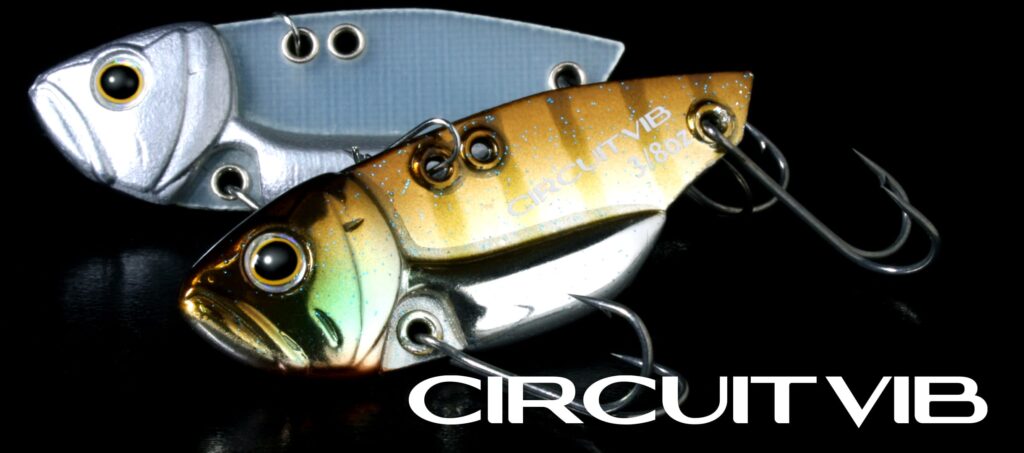
Fishing during the coldest times of the year requires a different approach to catch fish consistently. Many times, bass are much closer to the bottom and not as active in the dead of winter, so finding them with your electronics can be a little tricky. Your lure choices are also limited to baits along the bottom, so a blade bait like a Deps Circuit Vibe is a top choice for many winter anglers, including Canyon Lake, California’s Jordan Collom.
Collom has been a longtime fan of blade baits and shares his approach to fishing the Circuit Vib.
How to Use the Circuit Vib
Blade baits can be fished several ways, but a simple lift and drop retrieve is excellent. This allows the bait to vibrate with each lift and freefall on the way down, imitating a dying baitfish. Collom has had the best success in the winter by fishing the Circuit Vib right below the boat.
“It’s great in the dead of winter when you are around balls of baitfish that are near the bottom but you don’t see any bass on your electronics,” he said. “When you hop the Circuit Vib up and down, it’s like all of those fish that were sucked right to the bottom start to appear on your electronics like they’re all coming right to you. This is the perfect scenario when the fish are not actively feeding but are in the area.”
The bait has two slots for the snap and line tie, each giving the bait a different fall and vibration. Collom prefers the front hole, so the bait has less of a nose-down fall, and he says the unique sound makes the bait excel. “The circuit board material they use gives it much more vibration than other blade baits, and it’s a totally different sound,” he said.

The “Lift and Fall” Technique
The approach to fishing a blade bait is straightforward: lift your rod and then let the bait fall on a slack line. The thing to master is your cadence, how quickly you lift your rod, and how high you bring it up each time. Collom adjusts this based on the day and often throughout the day based on bass activity.
“I like to start low with very small and short quick snaps of the rod,” he said. “This will get the bait to jump a foot or two off the bottom. Once you start seeing fish on your sonar and get them fired up, you can start ripping it like crazy. One little trick I’ve learned is that if you miss a fish, let that thing go right to the bottom, and they’ll go down and eat it out of the mud like a jig.”

Where to Use It
One key component of the right area is the presence of baitfish. Electronics can be used to find groups of shad, and Collom says some unlikely areas can be good at this time of year.
“It’s weird, but many of the best places are mud bottoms, straight dirt in bays in the middle of nowhere,” he said. “With your 2D sonar, sometimes you can see the color change down in the mud to see where the fish are, but most of the time, the bass won’t show on forward-facing sonar because they are so tight to the bottom. The main thing, though, is finding schools of shad out there, and even if you don’t see bass right away if you start hopping the bait, you’ll often see the bass appear.”
Selecting the Right Size and Color
The Deps Circuit Vib is offered in three sizes (1/4, 3/8, and ½-ounce) and plenty of great colors. Collom is straightforward with color choices and adjusts the weight of the bait based on the depth and how active the fish are.

“Wakasagi is a really good color, and so is a clown, and I usually start with a ½-ounce size and then downsize accordingly,” he said. “If I’m fishing anything deeper than 20 feet, the ½-ounce is great, and I’ll use the 3/8-ounce when fishing shallower than that. The other time I’ll switch is if the school is going and biting, and then they stop, I’ll use a lighter bait to try to get them fired up again.”
Recommended Gear
Fishing a blade bait can be done with baitcast or spinning gear, but Collom prefers casting gear and a shorter rod. His choice is a 6-foot, 10-inch medium heavy Phenix Maxim for the length and overall feel of the rod for this bait, and he pairs it with a 7.1:1 gear ratio reel and 12-pound fluorocarbon line.
“I like the shorter rod because you can have quicker snaps, and I also use straight fluorocarbon,” he said. “12-pound is perfect; I’m not a big braid-to-fluorocarbon guy for baits where you’re moving the rod a lot.”








